Do you know that our delicate lips, such an exposed and attractive part of our face, have no oil glands? This is why lips are more sensitive and crack on exposure to dry or cold weather. Dry lips, chapped lips or cracked lips are the same and are medically referred to as cheilitis. The skin on our lips is thinner than the rest of our body, due to which they are more prone to changes in extreme weather conditions, increasing their chances of getting chapped. This is why we commonly experience dry lips during winters. There is no need for any test to diagnose this condition, as looking at the lips is sufficient to know exactly what’s going on1.
The lips of anyone, at any age, can get chapped. Some of the major causes are1:
You can recognize if you have chapped or dry lips by making a note of the following symptoms:
To protect our lips from severe environmental conditions, we usually apply formulations known as lip balms. They help in keeping the lips moist, preventing further drying. Unfortunately, most lip balms available on the market are made up of chemical substances2. As an alternative, several natural substances can be used as home remedies for cracked lips. They can be used throughout the day and can also be used for more intense treatment at night.

Virgin coconut oil has several properties which makes it ideal for use as a lip balm. It moisturises the skin of lips, preventing dryness and giving them a healthy look. It may even help in keeping lips free of germs, preventing infection, owing to its potential of disinfecting and antimicrobial properties. Furthermore, its properties of easy spreading, smoothness and stability at room temperature make it easy to use3. We can use it by gently dabbing it onto our lips in the morning and at night as many times as needed.
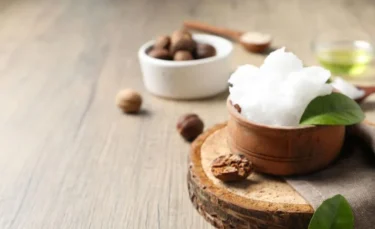
Shea butter is the fat extracted from the nut of the African shea tree. It is off-white or ivory in colour and is a common ingredient in many moisturisers. It acts as a rich softener and moisturiser for the skin, hair and scalp due to its semi-solid properties and buttery consistency. It also shows sun-screening activity, thus protecting against sunburns4. Therefore, shea butter can be a great addition for your lip care routine in winters. It can be used directly or by mixing with other oils for application over the lips.

Kokum seeds are used for obtaining kokum butter. It is a hard butter and is a stable solid. Kokum butter is used in the manufacture of soaps, moisturisers and cosmetics. It is a natural moisturiser and helps keep the skin smooth, supple and silky. Thus it’s a common favourite to treat severely dry skin, fissures of lips and lip ulcerations5. We can use it to make lip balms at home by mixing other ingredients, or we can directly apply it to dry or cracked lips.

The beans of cocoa are the source from which cocoa butter is obtained. Apart from chocolate that we all love, cocoa beans provide butter that is fat-rich and provides a creamy softness. It provides intense nourishment to our lips, moisturises them and helps them heal when they are dry and chapped. In addition, it contains antioxidants (free radical neutralising compounds)2. Cocoa butter is commercially used in making lip balms and lotions. It can also be used to make homemade lip balms for application over dry lips. We can simply use it by mixing it with another oil as well.
Ghee is naturally a powerful carrier. Even the smallest amount of ghee on lips can keep them hydrated and moisturised for a lot longer than an average Chapstick. Ghee on Lips can exfoliate and lighten dark Lips -Ghee on Lips can make your lips appear plumper – Ghee is extremely emollient
Dr. M.G. Kartheeka, MBBS, MD(Pediatrics)
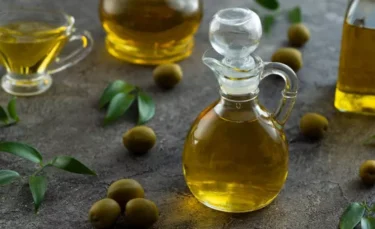
Olive oil has been in use for skin problem for ages in various parts of the world. Animal studies have shown that olive oil has properties such as reduction of oxidative stress (antioxidant), alleviation of inflammation (anti-inflammatory) and promotion of skin regeneration, which are beneficial for the healing of the skin6. Therefore, olive oil can also be used to heal the cracked skin of lips. We can directly apply it over cracked lips. Consuming olive oil by utilising it for cooking has also been suggested.

Sunflower seed oil contains high amounts of a fatty acid known as linoleic acid. This makes it suitable for use in various skincare products, as linoleic acid has numerous properties beneficial for the skin. Studies have shown that sunflower seed oil provides hydration to the skin and helps in the maintenance of skin cell structure6. Thus, sunflower seed oil can be used as a home remedy for dry lips. It can be used by either direct application or in cooking.

As the name suggests, it is the wax produced by bees. Waxes of various kinds are used for skincare products; among them, beeswax is very common. It is extremely helpful to help heal dry and chapped lips, as it contains natural compounds (fats) which help in moisture retention. In addition, it also protects the skin from ultraviolet (UV) radiation7. These protective effects of beeswax on the skin, especially on the tender skin of lips, make it a hit with lip balm manufacturers. We can apply beeswax on our lips after diluting it in a preferred oil. You can obtain natural beeswax and use it without any additives too. Be careful, you might want to skip beeswax if you are vegan.
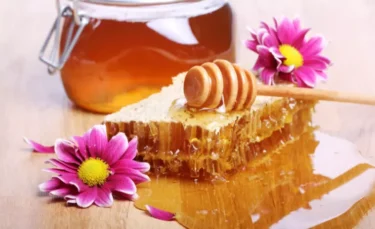
Honey is another product of a bee’s labour which is known for its innumerable uses in medicine. Honey has been used for a long time in the treatment of various skin-related diseases. It is used to treat cuts and wounds, as it promotes skin cell repair and activity against various microorganisms (antimicrobial activity). The use of honey in skincare products is extensive8. Honey can be used to heal the dry, chapped skin of lips by its application on the surface due to its moisturizing, anti-inflammatory and soothing properties.
Applying lip balm regularly, a balm with SPF 30 or higher every 2 hours when you are outdoors, should ease your discomfort. Severely chapped lips may take around 2-3 weeks to recover completely.
Dr Ashish Bajaj, M.B.B.S, M.D. in Clinical Pharmacology and Toxicology
It is advised that you should seek medical attention and consult a doctor:
Also Read: Home Remedies For Pink Lips
With increasing awareness, almost all of us make sure to follow a skincare routine, as we should be doing, but we often neglect our lips. We can protect our lips from dryness and prevent their chapping by following simple home remedies using natural products like shea butter, virgin coconut oil, honey, etc. So take care of your skin, and do not forget your lips.
Yes. Chapping of lips can be due to sunburns, hot, cold or dry weather, among many other reasons1.
Cracking of lips and slight pain in them are symptoms of dry lips. Dry lips can occur as a result of very hot, dry or cold weather, sunburns, allergies, etc. They usually heal when treated by applying lip balm or home remedies like virgin coconut oil, olive oil, honey, etc. If they do not heal over a long time and after repeated efforts, please contact your doctor1.
No. Dry lips are not caused due to calcium deficiency. There is no evidence for this myth. Drying of lips can be a result of extreme weather conditions (too hot or too cold), sunburns, dehydration, vitamin B or iron deficiency, autoimmune disorders, allergies, thyroid disorders and frequent licking of lips1.
Yes. Virgin coconut oil has a moisturising effect on the lips and helps heal dry lips3.
No. In contrast, honey is good for chapped lips, as it helps in the regeneration of its skin and promotes wound healing8.
Yes. Kokum butter can be used to make lip balms. It provides a shine and softness to the skin. It is commercially used to make cosmetics like lip balms, skin lotions, soaps, etc5.
1. Cleveland Clinic [Internet]. Chapped Lips; [cited 2022 May 19]. Available from: https://my.clevelandclinic.org/health/diseases/22005-chapped-lips
2. Kokil S, Kadu M, Vishwasrao S, Singh S. Review on Natural Lip Balm. Int J Res Cosmet Sci 2014 Aug;5(1):1-7. Available from: https://www.researchgate.net/publication/301204451_Review_on_Natural_Lip_Balm/link/570c7e5008ae8883a1ffeed2/download
3. Pandiselvam R, Ramarathinam M, Beegum S, Mathew AC. Virgin Coconut Oil Infused Healthy Cosmetics. Indian Coconut J 2019 Sept;1:30-2. Available from: https://www.researchgate.net/publication/336232293_Virgin_Coconut_Oil_infused_healthy_cosmetics
4. Israel MO. Effects of Topical and Dietary Use of Shea Butter on Animals. Am J Life Sci. 2014 Nov;2(5):303-7. Available from: https://www.researchgate.net/publication/277021242_Effects_of_Topical_and_Dietary_Use_of_Shea_Butter_on_Animals/link/555f900508ae9963a118b426/download
5. Chate MR, Kakade SB, Neeha VS. Kokum (Garcinia indica) Fruit: A Review. Asian J Dairy Food Res. 2019 Oct;38(4):329-32. Available from: https://www.researchgate.net/publication/340640816_Kokum_Garcinia_indica_Fruit_A_Review
6. Lin TK, Zhong L, Santiago JL. Anti-inflammatory and skin barrier repair effects of topical application of some plant oils. Int J Mol Sci. 2018 Dec;19(1):70. Available from: https://www.ncbi.nlm.nih.gov/pmc/articles/PMC5796020/pdf/ijms-19-00070.pdf
7. Kasparaviciene G, Savickas A, Kalveniene Z, Velziene S, Kubiliene L, Bernatoniene J. Evaluation of Beeswax Influence on Physical Properties of Lipstick Using Instrumental and Sensory Methods. Evid Based Complement Alternat Med. 2016 Oct;2016:3816460. Available from: https://www.ncbi.nlm.nih.gov/pmc/articles/PMC5141539/pdf/ECAM2016-3816460.pdf
8. McLoone P, Oluwadun A, Warnock M, Fyfe L. Honey: A Therapeutic Agent for Disorders of the Skin. Cent Asian J Glob Heal. 2016 Nov;5(1). Available from: https://www.ncbi.nlm.nih.gov/pmc/articles/PMC5661189/pdf/cajgh-05-241.pdf
Disclaimer: The information provided here is for educational/awareness purposes only and is not intended to be a substitute for medical treatment by a healthcare professional and should not be relied upon to diagnose or treat any medical condition. The reader should consult a registered medical practitioner to determine the appropriateness of the information and before consuming any medication. PharmEasy does not provide any guarantee or warranty (express or implied) regarding the accuracy, adequacy, completeness, legality, reliability or usefulness of the information; and disclaims any liability arising thereof.
Links and product recommendations in the information provided here are advertisements of third-party products available on the website. PharmEasy does not make any representation on the accuracy or suitability of such products/services. Advertisements do not influence the editorial decisions or content. The information in this blog is subject to change without notice. The authors and administrators reserve the right to modify, add, or remove content without notification. It is your responsibility to review this disclaimer regularly for any changes.
Blackheads, also called open comedones, are dark, tiny spots visible on the skin. They are open skin pores which get clogged with dead skin, oil and bacteria, while their upper surface darkens to form a blackhead. They commonly affect the face, neck, chest, and back areas. Considered as a type of acne, blackheads are usually seen in adolescents, but they can occur at any age. Blackheads can affect your looks and are generally considered unesthetic.
Although there are certain cosmetic treatments available to help you get rid of blackheads, some simple and natural products at home also show good results. In this blog, we will try to understand the science behind blackheads and explore some basic remedies that can be effective for managing blackheads at home.
Our skin all over the body has sebaceous glands, and most of these glands are connected to a hair follicle. These glands produce a waxy substance called sebum, commonly known as body oil. Comedones are formed due to inflammation of sebaceous gland or a hair follicle. Blackheads are open comedones that contain oil and keratin1. The following causes can lead to inflammation of a hair follicle or sebaceous gland:
Blackheads are dark, visibly open bumps on the skin. They are nothing but a milder form of acne. Blackheads look black on the surface of the skin as the sebum gets oxidized on coming in contact with air, not because they are dirty.
Some people try to pop blackheads or try to squeeze them out, in an effort to get rid of them. However, doing so is worsening the problem, not solving it. You may remove the clogged sebum from the blackhead but leave behind a scar. In addition, the open pore can get filled with more oil or bacteria in the course of time. Also, there are chances that the entire blackhead is not removed, leaving behind some part that might get infected later. Instead, trying out some simple home remedies to remove blackheads can be a safer and more natural option. These may include:
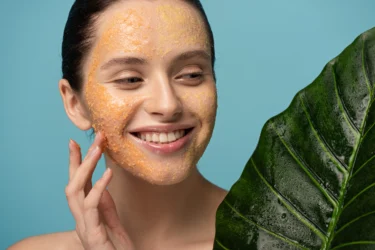
Exfoliate the surface of your skin using a salt or sugar scrub. The natural roughness of these substances removes the dead cells on the skin surface that clog the open pores.
Do the following steps:
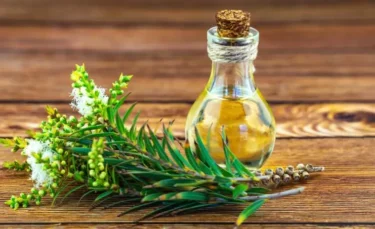
Tea tree oil can stop bacterial growth.
Tea tree oil is an essential oil obtained from the ends of branches and leaves of Melaleuca alternifolia tree belonging to the family Myrtaceae. Tea tree oil has antioxidant, antibacterial, antifungal, and antiviral properties that help fight bacteria, virus, and help scavenge free radicals. That’s how it can be very helpful in several skin conditions2.
Use tea tree oil as follows to get rid of blackheads:
NOTE: Do not take tea tree oil orally. It is toxic if taken orally at higher doses. Oral poisoning in adults and children has been well-documented3.
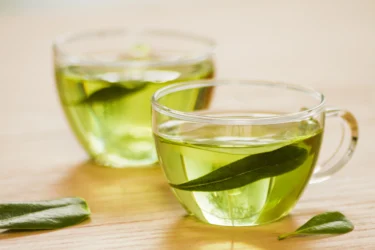
Green tea is an antioxidant. The oil production in your skin can be reduced with the help of wet green tea leaves4. Not just that, green tea has several other health benefits too. These are mainly due to the polyphenols present in green tea, which have antioxidant and antimicrobial properties, helping to fight bacteria, viruses, and free radicals.
To eliminate blackheads, use it as given below:

Honey naturally has moisturising, antiinflammatory and antimicrobial properties that can help reduce breakouts of blackheads5. It can also act as a gentle exfoliant to remove dead skin cells. Use it as follows:
You can combine it with cinnamon or yoghurt to make a gentle face mask.

Aloe contains natural compounds like alocien that help fight inflammation and aid in improving skin health. Aloe vera also has an antibacterial action that may help avoid acne6. To remove blackheads, aloe vera gel can be used as follows:
A study7 showed that retinoids, used for acne treatment, showed better results when combined with aloe vera.
Though there are studies that show the benefits of the given herbs and home remedies in this condition, these are insufficient and there is a need for further studies to establish the true extent of the benefits of these herbs and home remedies on human health. Although, considering their general benefits on skin and effectiveness in acne management, these can be promising options for getting rid of blackheads at home. Yet, these should be used under the guidance and supervision of your Ayurvedic physician.
Also Read: Effective Home Remedies for Period Pain
Most blackheads subside in early adulthood, but some people continue to develop blackheads all their lives. It depends on how deep the blackheads are rooted in your skin. Mostly, they disappear on their own if they are close to the skin surface, but some blackheads get deeply rooted in the skin. These blackheads have a slim chance of resolving on their own.
You can seek medical help if you have repeatedly new or old embedded blackheads. Consult a skin specialist (dermatologist) for the removal of blackheads. They will safely remove the whole blackhead, which will prevent them from recurring. The basic extraction procedure makes use a small tool with fixed metal loops on the ends. These tools are called come-done or blackhead extractors. They apply slight pressure around the blackheads and safely remove them8. Other procedures like microdermabrasion, laser or chemical therapy may also be used as deemed necessary by your dermatologist.
Ideally, you must not self-diagnose or rely on home remedies for the treatment of this condition. You should consult a qualified doctor for any advice on the condition.
Also Read: Natural Home Remedies for Malaria
Blackheads are a common skin condition that appears as dark, tiny spots on the skin. They mainly affect teenagers but can occur in all age groups. Simple home remedies that might be helpful for getting rid of blackheads include green tea, tea tree oil, sugar scrub, or a salt scrub.
If you feel too self-conscious due to blackheads or have old/recurring blackheads, you should consult a skin specialist for appropriate treatment.
Also Read: Best Home Remedies For Whiteheads
Yes, blackheads are very common in teenagers but can affect people of both genders in all age groups.
Blackheads are clogged hair follicles that reach the skin surface and open. They appear black in colour.
Whiteheads are clogged hair follicles that stay under the skin and form a white bump. Both of these can affect your appearance.
No, blackheads are not contagious and do not spread from one person to another. Blackheads are not an infection.
You can consult a dermatologist or a cosmetologist if you feel anxious and want to get them removed.
You should always consult your doctor before taking any medicines for blackheads. You may use mild scrubs available over the counter. However, avoid consuming any oral medications or local applications to get rid of them. There is a high risk of harm or side effects.
Disclaimer: The information provided here is for educational/awareness purposes only and is not intended to be a substitute for medical treatment by a healthcare professional and should not be relied upon to diagnose or treat any medical condition. The reader should consult a registered medical practitioner to determine the appropriateness of the information and before consuming any medication. PharmEasy does not provide any guarantee or warranty (express or implied) regarding the accuracy, adequacy, completeness, legality, reliability or usefulness of the information; and disclaims any liability arising thereof.